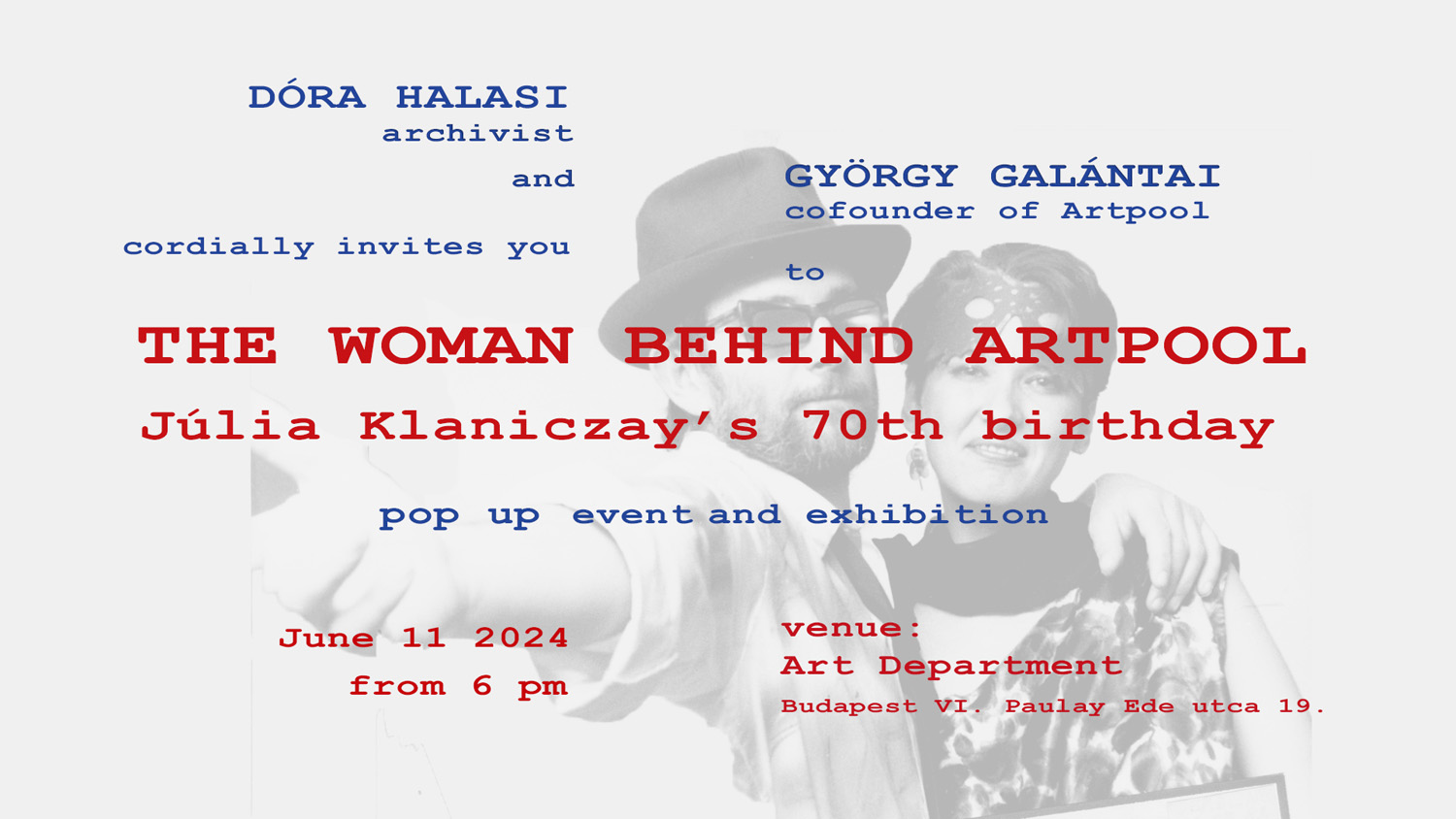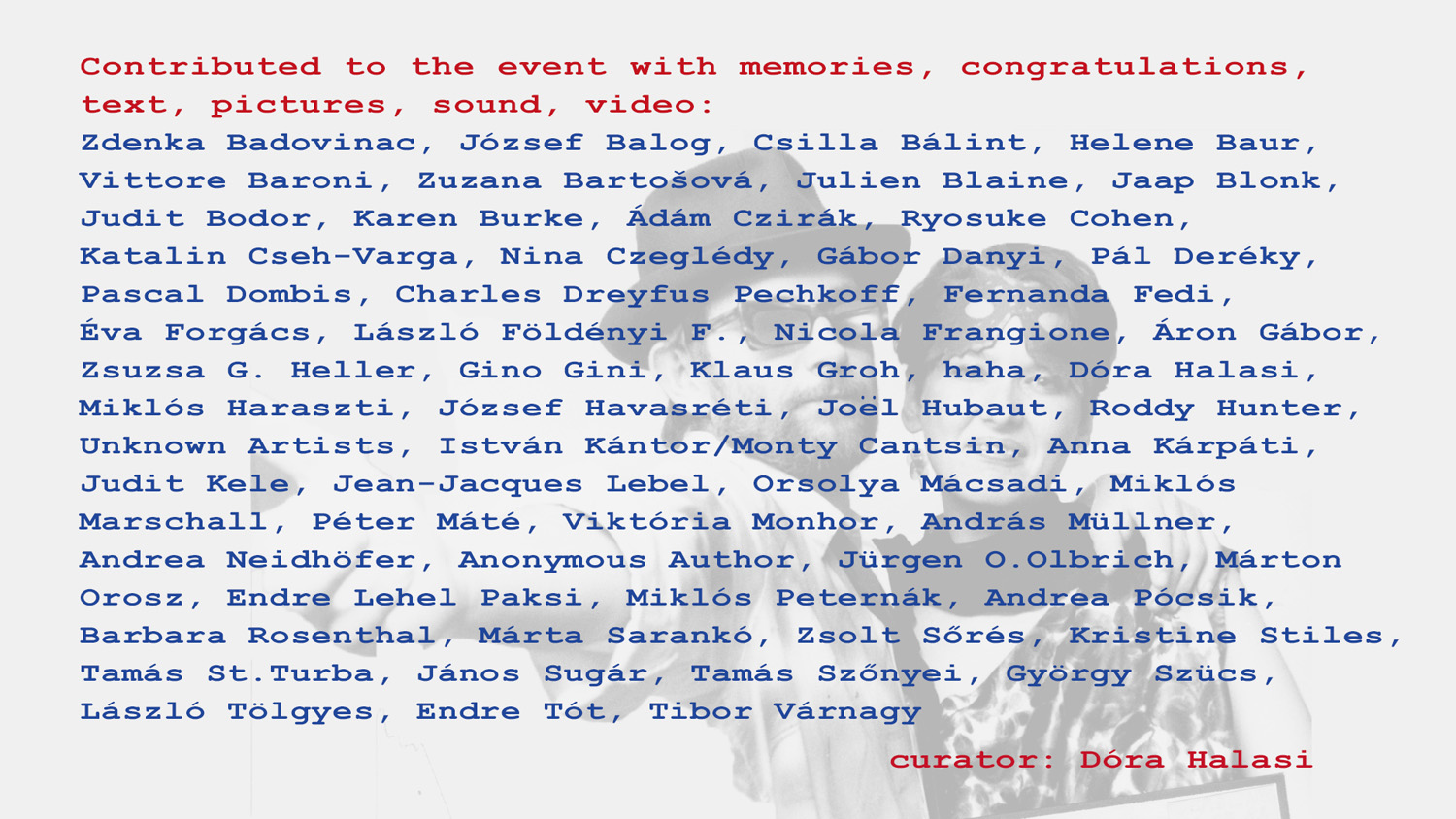Birthday messages and memories on the occasion of the 70th birthday of Júlia Klaniczay, co-founder of Artpool
Péter Máté
Dear Juli,
fragments of memories, with love, on your round anniversary…
Our relationship, representing a tiny segment in Artpool’s history, began in spring 1992, when the Local Government of Budapest ended the Budapest Art Weeks, by then stripped of its original content, and entrusted the Szabad Tér Színház [Open Air Theatre], as a successor, to launch a new, contemporary art festival that autumn. Mihály Sárdi – the first real manager as well as the heart and soul of the Budapest Autumn Festival, and the dramaturg of the theatre at the time, if I remember well – invited me to co-organise the festival with him. Rather daunted by the task at hand, we first tried to see who our suitable partners would be. On the art scene of the day, which had suddenly been freed from the constraint of the government’s cultural policy known as the 3Ts, the progressive and experimental artists as well as budding institutions, which had up until then been forced into underground operation, emerged one after the next.
I had only faint knowledge of an institution called Artpool. I had heard about its fine art and performance art actions and some about the Boglár Chapel but somehow it was all on the sidelines because I was interested in other things. Sárdi was far better equipped with knowledge in this regard and immediately said that Artpool is essential and that we had to contact them. That’s how we ended up on Liszt Ferenc Square.
On the side: Liszt Ferenc Square was more like an urban jungle back then, overgrown, full of litter, street kids and vice-caretakers, with nothing suggesting that it would soon be home to an elegant row of restaurants and a popular meeting place.
So we ended up in a room packed with documents and folders, where Juli Klaniczay and Gyuri Galántai (or Gyuri and Juli, for me they are one and the same to this day, I would find it difficult to tell who gave me what ideas, advice and told me which stories) inundated us with their ideas. I was overwhelmed and it was obvious that compared with them we were total beginners in these matters. One of the consequences of this brief encounter, was that I kept returning to Artpool and became a regular there. We had lots of conversations, they told me many stories and in the meantime we were trying to find a realistic and financially feasible framework for the FluxFlag exhibition and festival, which was bound to reduce our originally ambitious plans.
During one of our conversations, Artpool – I couldn’t say if it was Juli or Gyuri – started to piece the puzzle together in my head, helping me to realise the significance of this festival. One of them said that it is an umbrella festival, which invites and welcomes individual artists, groups and initiatives of all kinds but sharing the element of being progressive, experimental and contemporary… presenting different segments of the art scene. Budapest Umbrella of Contemporary Arts – I kept humming to myself as I was walking down the stairs. From then on, this umbrella became the festival’s mission statement and the turbo umbrella its emblem for quite a long time.
Going back to FLUXFLAG, we managed to collect and mount more than a dozen flags on the square and celebrated with concerts and performance art under them, by the Franz Liszt statue.
And this is where the urban jungle and the kids, bored and loafing about on the square, come in the picture: as a form of light evening exercise, they climbed up the posts and tore off the flags. It was not exactly an ill-meaning bunch of kids, because when Juli alarmed us and I arrived at the square, they were helpfully pointed us to some of the flags, a bit torn and chucked under the bushes, and they even promised that they would refrain from tearing them down in the next few days, but by then we had grown exhausted by it all and moved the flags back into the archives sooner than planned. It was perhaps at this or maybe the next festival that video was made, which is very memorable for me: with a camcorder just handed to him, Gyuri recorded the reactions of the residents on the square. A woman, who looked like a vice-caretaker, was screaming that he should switch off his camera immediately and that she was an expert, working at the Hungarian Radio (perhaps a dramaturg?) so she knew exactly where underground [culture] belonged, and that it should go back there, under the ground, into the cellars. I really loved this recording and watched it at their [Juli and Gyuri’s] place several times, and I they even have it still among their cassettes.
They invited Ben Vautier for the next festival. He had his exhibition on the square, and for that occasion they renamed the square ’Ben Square’, putting the signs up everywhere around the square next to the street signs. This led to some town protection association reporting the festival at the Metropolitan authorities, saying that we confused the residents and ambulances lost their way because of what we did, and whatever else they could think of. I had no choice but to start a lengthy correspondence with an overzealous and ill-mannered assistant clerk (the letter, I think, is still there somewhere on the Artpool homepage). Of course, this is not what made Vautier and the exhibition important for me. During the same Autumn Festival, American filmmaker Jonas Mekas was a guest at the Toldi cinema, and during Vautier's speech he suddenly appeared on the square, as usual with his camera. Then I suddenly felt that our festival had become the Fluxus world’s meeting place (well, ok, only for those 15 minutes, but even that felt really good).
Then so many things happened over those twelve years: Ernst Jandl, sound poetry, Miklós Erdély…, and somehow Liszt Ferenc Square was spared scandals, both real and staged.
And then there was Kapolcs, and the Valley of the Arts, where – for some time – there was enough room for people in the streets and the locals of Kapolcs were the participants and not the hosts of their festival. With space being restricted [at the Valley of the Arts], the Artpool garden, i.e. Juli and Gyuri’s house, became a great safe haven, where another kind of festival was taking place, with groups of children playing with stamps in the house, while we were sitting peacefully in the garden, under Gyuri’s monumental shoe sole sculptures, listening to his stories about them and about why Viktor Lois is making music on typewriters, and many other things that I no longer remember if I heard about them then and there and from them.
In those days it occurred to me a few times that Juli and Gyuri could feel at ease (or rather at unease) borrowing the motto of Paris: Fluctuat nec mergitur ([She] is tossed [by the waves], but does not sink). “It is joyful to see that there is no threat of demersio (sinking) now,” I was writing about two weeks ago, and then I put my text aside for later rereading to wish you all the best.
Péter Máté, organiser of the late Budapest Autumn Festival
and Edit Rajnai, fellow traveller
(2024)

